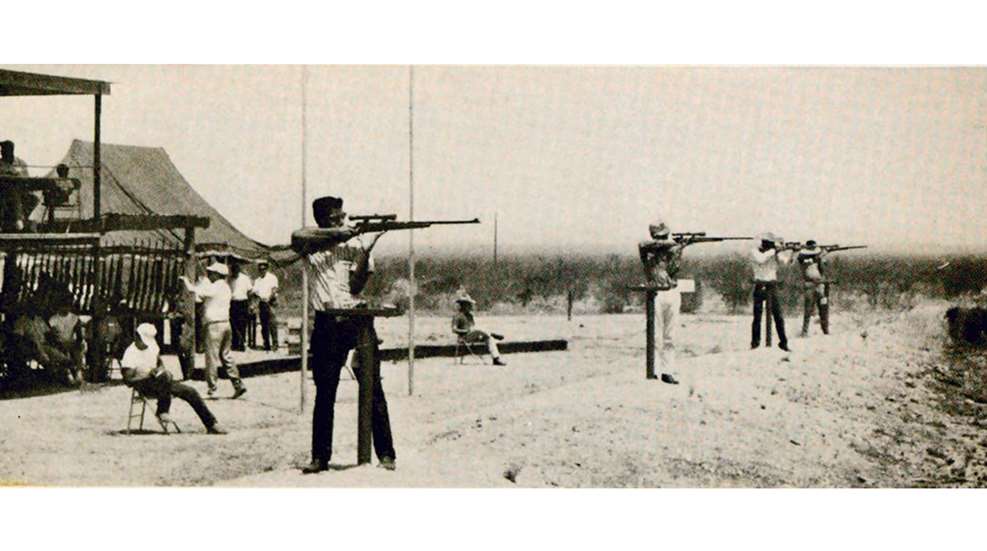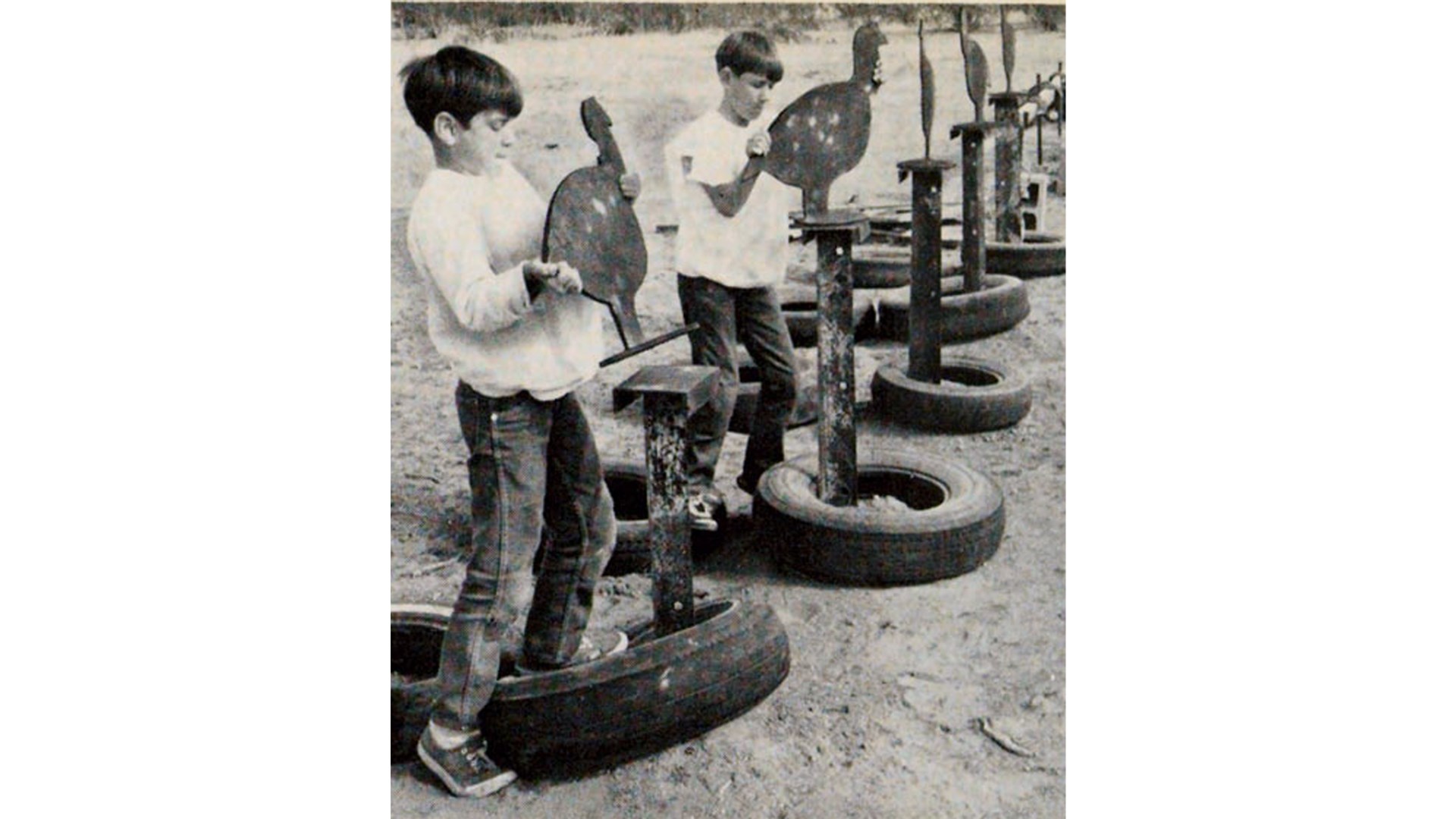
These articles appeared originally in the July 1970 issue of The American Rifleman. To subscribe to the monthly magazine, visit NRA’s membership page.
Along the U.S.-Mexico border, where the cultures of the two nations merge, a new sport shooting game is growing—the Silhoueta Shoot.
North of the border, it is generally called "A Mexican Turkey Shoot" or "Mexican Silhouette Match."
Deep in Mexico, and even along the border in some places, it is fired at live animals, and if the shooter draws blood, the animal is the prize.
But the new U.S. ranges, and most Mexican ranges of today, consist of animal cutouts made of armor plate or a special type of plate steel. The latter can be half-inch T-1 or Jalloy steel plate. If armor plate can be found, three-eighths inch will do fine. The close range silhouettes-200 and 300 meters—especially, require this tough steel.
A single range—sufficient for four shooters on the firing line per relay— consists of five chickens at 200 meters; five pigs, usually the wild javelina, at 300 meters; five turkeys at 385 meters; and five sheep (a new Tucson range uses about a half-size cutout of a desert bighorn ram) at 500 meters.
Ranges may be in multiples of this layout to accommodate more shooters on the firing line at one time. Most use two layouts. The silhouettes are welded to a flat base about five inches in diameter and sit on a flat surface. They must be knocked over for a hit. A shot that merely turns the target around is scored as a miss.
Efforts are now being made in both countries to standardize and adopt uniform rules and procedures as well as uniform specifications for ranges, targets, arms, scopes, and other shooting equipment.
Generally, most ranges forbid use of shooting coats, slings, and target scopes (warm jackets are okay; but not heavily padded). However, there is no restriction on hunting scopes, including the varmint scope with target-type mounts used by most top U.S. shooters in these matches. Those who wish may use more than one rifle, even a different arm at each range. The rifle is limited to four kilos—about 8-1/2 pounds—without scope. Any caliber 6 mm. or larger may be used, but power equivalent to the .308 Winchester or .30-06 is desirable to knock over the heavy targets at the longer ranges. Armor piercing ammunition is barred, but full-patch military ammunition or match ammunition is okay.
No sighters are allowed during a match, so shooters must sight in and record their sight settings prior to the match.
 Sonoran League silhouette targets (l. to r.) include peccary, wild chicken, turkey. Bullet pocks are an inevitable form of damage.
Sonoran League silhouette targets (l. to r.) include peccary, wild chicken, turkey. Bullet pocks are an inevitable form of damage.
All shooting is done in the standing position or off-hand without palm rests or hooked buttplate. It is essentially a hunter's match, and rules are designed with that in mind. Each shooter is allowed 2-1/2 minutes for his five shots at the animal he is assigned. Each target must be fired at in order from left to right, and a hit on the wrong target is scored as a miss. Each shooter has a scorer. The shooter may be drawn to begin at any one of the ranges, but regardless of where he begins, he continues to fire in order at the four different banks of targets. If he starts on the 500-meter sheep, for instance, on his second relay he will go to the 200-meter chicken, and his match will end on the 385-meter turkey.
Either single or multiple loading is allowed, and there is no weight limit on triggers. But unsafe rifles may be ruled off the range.
Shooters are divided into two classes to make competition more interesting to the beginner, who automatically fires in Class B. To become a Class A shooter, he must knock over five animals in each of two matches, not necessarily consecutively.
Ordinarily from seven to 10 hits will win a match, which consists of 20 shots (recently revised to 40-10 shots at each animal).
At a recent match in Tucson before the number of shots was doubled the winner had 10 hits; second place had nine, and third, eight. Class B was won with seven hits (incidentally by NRA Director Jim Holden who was firing his second match and moved into Class A after the match). Second in Class B scored six hits, and third was a six-way tie, with five hits each. Under the match's rules, the shoot-off begins with each competitor firing one shot at the 500-meter sheep. Those who miss are out if there is at least one hit. Then the shoot-off moves back one place at a time until a winner is determined.
For my first match I used two rifles. For the short ranges, I sighted a 7 mm Remington BDL with Weaver 3x9 Varmint scope, and pushed a 160-gr. Sierra boattail bullet with 4831 powder. One sight setting served at both ranges with this flat-shooting rifle. The javelina target is big enough so that the variance was not critical.
My Enfield 'Produced'
My second rifle was an old Enfield converted sporter in .30-'06 that had good balance for offhand shooting. I decided to use up an old box of Palma Match ammunition that had been lying around for 15 years because time was short for loading and I knew the ammunition performed well in the Enfield. I sighted this combination in on the 385-meter turkey. Three experimental shots at the 500-meter sheep indicated about 24 inches of Kentucky elevation.
Although I succeeded in knocking over two pigs and one target at each of the other ranges to get in the sixway tie for third in Class B, the value of using one rifle was very apparent, particularly because of the effect of different triggers.
Two widely known riflemakers at Tucson, Roy Dunlap and Harry Lawson, are providing some special guns for this new sport.
Dunlap favors the .308 Winchester cartridge, with a barrel as heavy as possible within the weight limit imposed by the rules. Such a rifle, although on the heavy side, still can be used for hunting.
Silhouette shooting is a fine spectator sport with many "Oles" and cheers when a shooter knocks over a target. And the shoot-off of a tie is especially exciting when the shooters take the line for the sudden-death elimination. They begin with one shot each at the longest range, then move backwards over the course with one shot each at the different animal cut-outs until a winner emerges.
—Ben Avery
Mexican Silhouette Offers Small Target, Big Challenge
Shooters in the Sonora district of Mexico are generally credited with originating the Mexican Silhouette Match. Author Gene B. Crum takes a close look at match practice in Sonora, giving details on targets, rifles and loads.
One of the things which injects challenge into the Mexican Silhouette matches is the fact that, with one exception, target surface areas are the size of Olympic bullseyes for their respective distances.
This means that the silhouettes are very small when viewed across a set of sights.
 Youngsters replace turkey targets between relays of Tucson silhouette match.
Youngsters replace turkey targets between relays of Tucson silhouette match.
At 200 meters, the closest target, the gallina (chicken) looks like a scrawny bantam hen. From this distance, it has a disconcerting way of fading out altogether when iron sights are used. Even through a strong 'scope, the image isn't much more reassuring. Nevertheless, the chicken is the second most often hit of all the targets, due to its relative closeness to the firing line.
Most popular target is the jabali, or peccary, styled after the swift little pig which haunts the desert washes. Set at 300 meters, the target is the exception to the Olympic sizes of the other targets. Because it is relatively larger than the others, most shooters try to build a scoring "cushion" on the jabali to counteract failure on the other targets.
At 385 meters is the third target series, the guajolote (Mexican turkey) silhouettes. Much of the aiming area of these targets is lost to the shooter because of the long neck, head, and legs of the bird, and they are notoriously hard to hit. Their distance makes a specific sight change necessary if the shooter doesn't want to "guesstimate" the winds and rapidly increasing bullet drop.
The turkeys are usually perched atop poles four to five feet high. Lacking a whitened backstop, they are not only difficult to see; judging misses is almost impossible.
Sited at 500 meters, the borrego or sheep target is difficult to hit and, with many rifle calibers, difficult to knock down.
In Sonora, good shooters will normally knock down from three to five targets per match. Matches are often won by flattening no more than seven targets out of the possible 20 (Upward revision of shots fired will undoubtedly change this.—Editor).
For several years, the record number of targets knocked down in any one match was 10. In October, 1967, a Sonora shooter, Rafael M. Chavez. set a new record by downing 11. His rifle was a home-customized .30-06 Springfield sporter, mounted with a Weaver 10X scope.
Chavez' use of the .30-06 for the major share of his silhouette shooting is in line with the match practice of most other Mexican shooters. A gun rack census at any given Sonoran match will show that the .30-06--usually in a sporterized military rifle—mounted with a 4X scope (usually Redfield or Weaver, followed by Japanese brands) is the preference of 75% of the shooters. The rest are a conglomerate of .270's, 6 mm's, and various wildcats based on the .30-06 case.
Many Shooters Reload
Although many shooters use surplus military ammo, reloading is carried on by the majority of shooters, generally with the use of community-owned presses in the local shooting clubs. The most universally favbred load is, for the .30-06, either an Alcan or CCI primer igniting a suitable load of 4831 powder in a surplus U.S. military case, pushing the Sierra 168-gr. International Match bullet.
If the Sierra bullets aren't available, then the common practice is to substitute 150- or 180-gr. bullets of any brand (most commonly Centrix) ahead of charges as hot as possible. Mexicans believe it is necessary to have as much wallop as possible at long range. Otherwise, a hit may fail to knock a target down.
—Gene B. Crum




































